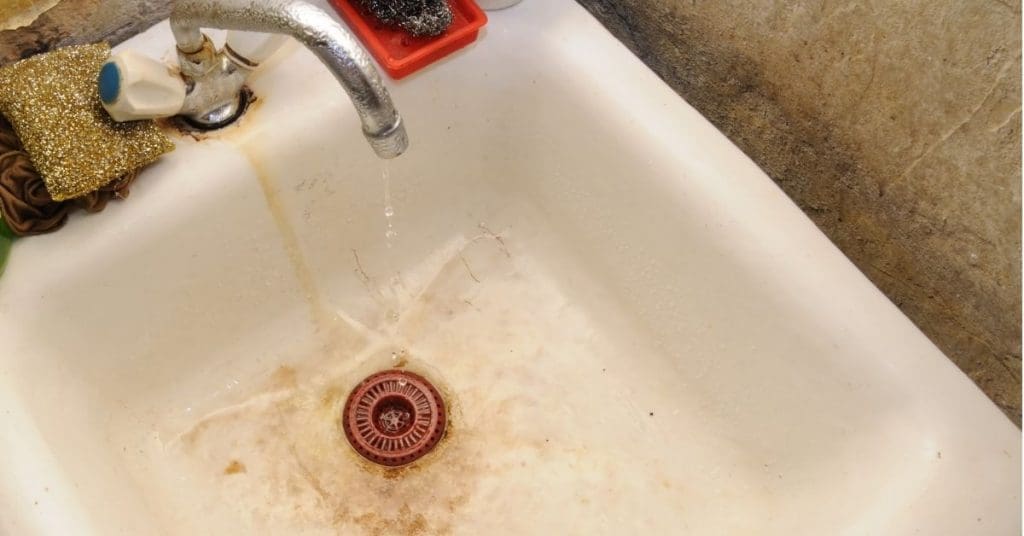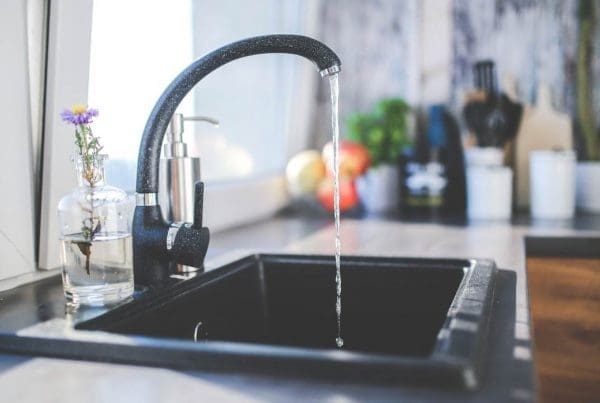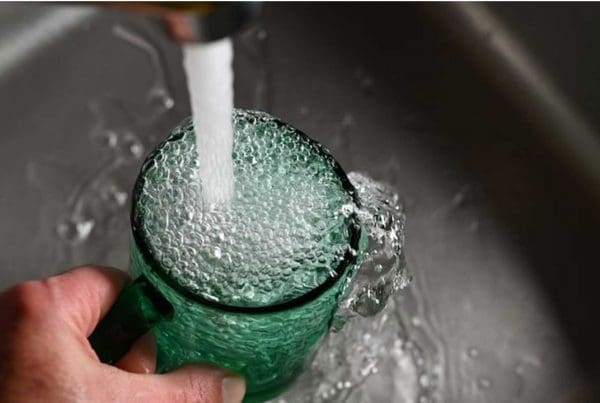Iron in Water
Did you just turn on your kitchen sink, only to discover reddish-brown water spraying out of the tap? Does your water smell like rotten eggs? Do you notice a small stain that looks like rust in your shower?
We have some bad news—you likely have excessive iron content in your water. Iron makes up about 5% of the earth’s crust, making it the second most abundant element. Iron is mainly present in water in two forms: either soluble ferrous iron or insoluble ferric iron. Water containing ferrous iron is clear and colorless because the iron is completely dissolved.
When exposed to air in the pressure tank or atmosphere, the water turns cloudy and a reddish-brown substance begins to form. This sediment is the oxidized or ferric form of iron that will not dissolve in water. Some soil and rocks in Indiana contain minerals very high in iron. As rain falls or snow melts on the land surface and water seeps through iron-bearing soil and rock, iron can be dissolved into the water.
 In some cases, iron can also result from corrosion of iron or steel well casing or water pipes. Similar to how iron in a metal pail turns to rust when exposed to water and oxygen, iron minerals in the water turn to rust and stain plumbing fixtures and laundry. Iron also occurs naturally in green vegetables, red meat, fish, and even rice and fruits. Essential for good health, iron helps transport oxygen in the blood. While it is necessary for our bodies, too much isn’t a good thing.
In some cases, iron can also result from corrosion of iron or steel well casing or water pipes. Similar to how iron in a metal pail turns to rust when exposed to water and oxygen, iron minerals in the water turn to rust and stain plumbing fixtures and laundry. Iron also occurs naturally in green vegetables, red meat, fish, and even rice and fruits. Essential for good health, iron helps transport oxygen in the blood. While it is necessary for our bodies, too much isn’t a good thing.
How To Know If There’s Too Much Iron in Your Water
Taste
Dissolved ferrous iron gives water a disagreeable metallic taste. When the iron combines with tea, coffee, and other beverages, it produces an inky, black appearance and a harsh, unacceptable taste. Vegetables cooked in water containing excessive iron can also turn dark and look unappealing.
Color
If your water looks yellow, reddish-orange, or brown, you probably have too much iron in your water. If you have too much ferrous iron, your tap water is first clear and colorless. After standing, reddish-brown particles appear and settle at the bottom of the glass. If your tap water appears rusty or has a red or yellow color and after standing the particles settle to the bottom, you have too much ferric iron in your water. Your water may still be safe to drink, but it will look less appealing.
Stains
Iron leaves residue behind, staining everything it comes into contact with. Expect dark stains in your shower, toilet, and bathtub; orange stains on your plates and cutlery; and dark stains on clothes washed with water containing iron.
Pipe Buildup
Over time, iron sediment and residue can build up in your home’s pipes and cause clogging or poor drainage. If a pipe clogs badly and requires professional attention or if built-up pressure causes a leak, you may spend a lot of money on repairs.
Dry & Itchy Skin
Iron in the water we use to bathe or shower can dry out your skin. Soap and iron don’t always mix well together, so washing with iron-laden water can sometimes leave excess soap residues on the skin that cause dryness and itching.
Bacteria Growth
Rarely, bacteria known as iron bacteria combine with iron to form rust and bacterial slime. They do not typically cause disease. However, research has shown that the presence of iron in water can promote the growth of bacteria like E. coli. Particularly if you have well water, you’ll want to test your water regularly to make sure it has not become contaminated with harmful bacteria.
How Can I Test For too Much Iron?
Free Water Analysis
Effectively treating iron depends on the form(s) of iron present, the chemistry of the water, and the type of well and water system. It is best to work with a water treatment specialist to find the best solution. Our WQA certified technicians will come to your home and provide an analysis of your city or rural water and answer any questions you may have. Your visit will take 30–45 minutes and will be scheduled at a time that’s right for you.
How Can I Remove Iron From My Water?
To remove iron from drinking water, you’ll likely want to invest in water treatment solutions like a water softener, sediment filter, and well cleaning.
Water Softeners
Water softeners literally soften water, by removing certain minerals. In most cases, this means excess calcium and other minerals, which are naturally occurring elements often found in well water, but also present in many municipal water supplies. While these minerals aren’t necessarily bad for your health, when they build up in your plumbing they cause all sorts of household issues.
Salt water softeners extend the life of your appliances by stopping mineral deposit buildup. They save money, using up to 50% less soap and detergents. Water softener systems keep your hair shiny and soft, keep your skin moisturized, keep your clothes brighter, and make taking showers more enjoyable. Soft-water systems are gentle on plumbing and don’t cause rust damage in sinks, tubs, dishwashers, and washing machines.
The most common and conventional type of water softener is the single tank water softener. It relies on a salt brine, like that saltwater you used to gargle for a sore throat when you were a kid. This system works by replacing the hard minerals (calcium, potassium, magnesium, iron, etc.) for sodium, which is softer. You won’t taste the sodium, of course, but you’ll “feel” it, in terms of better soap lather, softer skin, and cleaner dishes. Salt-based water softeners will also help extend the life of your home’s hot water heater.
Conventional water softeners need to regenerate from time to time. This typically happens overnight when everyone at home is asleep and there is no water demand. If freshwater demand persists in your home at all hours of the day and night, you might want to consider a dual-tank system. When one tank is offline regenerating, the other tank kicks in, and vice-versa.
The twin unit we offer has soft water regeneration instead of pulling raw earth water to clean the resin bed (like all single tank softeners). This ability to get the resin bed thoroughly cleaned, especially of iron, makes it possible for us to provide a softener that does not need an additional iron filter. Though a twin softener is more expensive than a single tank unit, our twin cost less to buy than the typical single tank softener combined with an iron filter.
Sediment Filter
This is a replacement cartridge used to remove large particles from the water supply to protect treatment equipment for your whole house. Because it removes the large particles before they get to your water softener and other treatment equipment, using a sediment filter will extend their life.
Well Cleaning
If your water source is a private water well, you need to maintain it. When the iron in the well water oxidizes it forms rust. If it isn’t mitigated, this rust can end up being pumped into your home. A professional water well cleaning is a vital part of keeping your system sanitary, running properly, and healthy for your whole family. We recommend a water well cleaning every 10 years.
If you are dealing with too much iron in your water, or aren’t sure, we have the skills and expertise to get you the water treatment you need at a reasonable price. Contact us today for more information!




